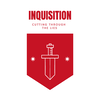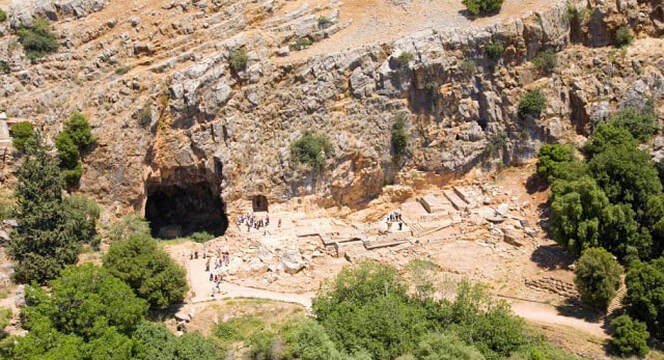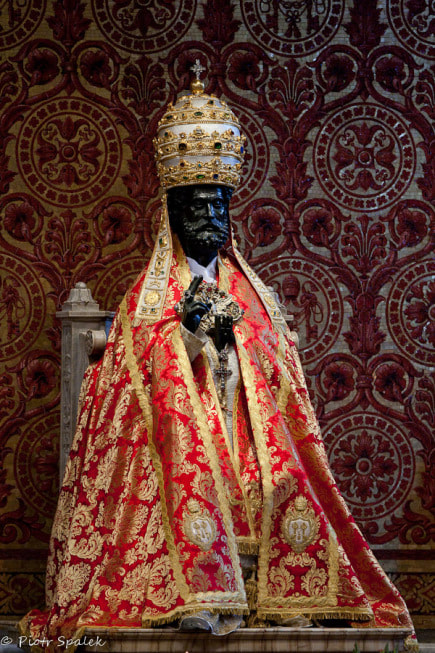|
Matthew 16:13-19 is for Catholics the signal Scriptural text that show that Christ intended to confer upon St. Peter the primacy over the whole Church, and at the same time grant him and the other Apostles the power to govern the Church with the Keys of the Kingdom of Heaven. Protestants, naturally, object to the Catholic interpretation of the text, saying that at most, all that happens is that Peter professes the Divinity of Jesus Christ, and that's really it. Of course, they'd have to deny the Catholic interpretation, since if the Catholic view is correct - and it is, incidentally - then the Protestant religion is demolished, for they would have to admit that the Catholic Church is the True Church of Christ, and that they are outside of Her communion, and, ergo, outside the Faith of Christ. Whatever Protestants profess in common with Catholics came solely through the Catholic Church, even the very Bible Protestants try to use against the Church. What Christ does at Caesarea Philippi is not done in a vacuum, but in complete fulfilment and continuity with Jewish practise. This fact is missed by our Protestant objectors, since, in general, most of them are completely ignorant of history and of context, hence why they abstract verses from the Bible out of context and apply a meaning to them that becomes patently absurd when said verses are read in context. As the English Cardinal John Henry Newman once said: To be steeped in history, is to cease to be Protestant. I agree with him. Both myself and St. John Newman were former Anglicans, so I can whole heartedly agree. So what happened at Caesarea Philippi? Well, let us find out. And I promise, it doesn't require a doctorate in anything. Only common sense and context. History of Caesarea Philippi We begin with the location. The city is located in the Golan Heights at the base of Mt. Hermon. At Caesarea Philippi there is a rock face that is over 100 feet up and 500 feet wide. When facing the rock face, on the left, there is an entrance to a cave, which was filled with still water that was over 800 feet deep. Today, the cave is blocked part of the way in due to an earthquake causing the cave to fill in. 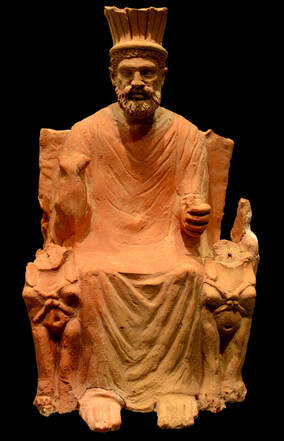 The Canaanite god, Baal. This statue depicts Baal-Hammon, the god worshipped by the Carthaginians, and to whom child sacrifice was offered. The Canaanite god, Baal. This statue depicts Baal-Hammon, the god worshipped by the Carthaginians, and to whom child sacrifice was offered. Pre-Hellenisation Before the Greeks conquered the Holy Land during the reign of Alexander the Great and during the Maccabean Revolt, the area was a place of worship to the Canaanite god Baal, under the name Baal-Hermon (who was associated with the spring at the site which comes out of the cave and is a source for the Jordan River), since the site is located at the base of Mt. Hermon. Baal was the chief god of the Semitic peoples of the Near East, and even the Jews engaged in worship of him during their days of infidelity against God. One of the frightening cultic rites to Baal was the sacrificing of children to him by fire. This child-sacrifice was also offered to another Canaanite god called Moloch, the worship of whom God damns as abominable. The Jews also engaged in worship of Moloch as well. In Carthage, Baal was worshipped as Baal-Hammon. When the Romans prevailed over the Carthaginian Empire during the Punic Wars, the citizens were convinced that the Roman victory (and subsequent destruction of the city) was because Baal-Hammon was angry with them. And so, in a frenzy to appease their god, they sacrificed 300 children to him. This is documented by the Romans themselves, although historians thought it anti-Carthaginian propaganda and didn't accept it as true, until it was revealed via archaeological discoveries that actually the Romans were right, and the Carthaginians really did sacrifice hundreds of their children to Baal-Hammon. But, I digress. Although child-sacrifice may not have actually occurred at the place where Caesarea-Philippi would later be built, it doesn't rule out the fact that the god worshipped there - Baal - was worshipped via sacrificial offerings of children. And so, the land already has a dark side. 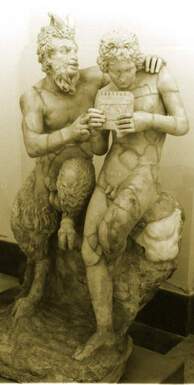 Left: Pan. Right: One of his lovers, the male youth Daphnis. Left: Pan. Right: One of his lovers, the male youth Daphnis. Hellenisation Following the expansion of the Greek Empire under Alexander the Great and the Seleucids, the spring was associated by the Greeks with the god Pan, who was the faun-god of nature (as the image, left, shows, Pan was half man, half goat). And thus, the Greeks named the place Paneas after him. Today, the site is called Baniyas, which is the Arabic form of Paneas. What is interesting is that the Greeks, and later the Romans, believe the cave at the site was the enterence to Hades, and so they built a set of gates in front of it, to keep the dead and the gods of the underworld out. Worship of Pan didn't involve child sacrifice, as far as I am aware, but he is said to have been a pederast (like many male Greeks gods), and as a god of sex, he is said to have engaged in perderastic relations with male youths. Pan was also believed to bring fertility, and so his rites often involved orgies and other sexual practises, including sex with goats. He was even sometimes depicted with a large erect phallus, and a lusty smile on his face as a result of this. So, another deity to whom disgusting rites were conducted was worshipped at the site. 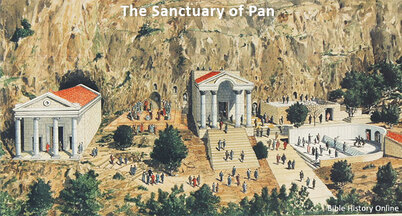 Caesarea Philippi in the days of Our Lord. Caesarea Philippi in the days of Our Lord. Roman Empire During the Roman Empire, the territory of the Panion, which included Paneas, was annexed to the Kingdom of Herod the Great. In honour of his patron, the Emperor Augustus, Herod erects a temple of white marble to Augustus (who was worshipped as a god), and erects the temple in front of the Cave of Pan (as seen in the image above). Later, after Herod's death, his kingdom is divided amongst his sons by Caesar, one of whom is Philip II, known as Philip the Tetrarch. Philip ruled over the Tetrarchy of Batanaea (the Latinised form of Bashan, the Amortie Kingdom). In 3 B.C, Philip II founds a city at Paneas, which he made the administrative capital of the Tetrachy of Batanaea. In A.D. 14, Philip enlarges the city and gives it the name Caesarea (in honour of Caesar) and Philippi (after himself, to distinguish it from the city of Caesarea Maritima which was situated on the Judean coast with the Mediterranean). The area is so notorious for its pagan practises, that rabbis warn Jews not to go anywhere near it. The Confession of Peter Enter Our Lord and God, Jesus Christ, and His Twelve Apostles. In His third year of Public Ministry (c. A.D. 32-33), Our Lord begins His preparation of the Apostles for His eventual entry into Jerusalem and for His Sacred Passion. In order that they are well prepared and having seen what He has said and done in the sight of the people, Christ must now extract the creed of the Apostles. He must get them to audibly profess the True Faith, namely, that He is True God Who became True Man, the Divine Son of the Living God. And we here read in St. Matthew's Gospel: And Jesus came into the quarters of Caesarea Philippi: and He asked His disciples, saying: "Whom do men say that the Son of Man is?" But they said: "Some John the Baptist, and other some Elias, and others Jeremias, or one of the prophets." Jesus saith to them: "But whom do you say that I am?" And so, Our Lord brings the Apostles to the very place that the rabbis have been telling them not to go to. One can only imagine the look on their faces as they approach the Sanctuary of Pan. They must have been freaking out. Our Lord doesn't enter the city, but goes to the Sanctuary of Pan just outside the city. So, imagine it. The True God is standing looking at the Temple of Pan, the Temple of Augustus Caesar, and the various idols placed in the niches in the walls of the rock face. Behind the Temple of Augustus, He sees the large cave, at the entrance of which is a set of gates, and which is believed by the pagans to be the entrance to Hades. He sees countless souls offering their worship not to Him, but in their blindness, to false gods; nay, to demons. One can imagine the look on His Face. He is saddened, but then gently smiles as He foresees that the descendants of these very pagans will accept Him as the True God. But, He must proceed with His preparing the Apostles for the coming Passion. The Apostles, on the other hand, are muttering about themselves. They are fearful, and questioning each other as to why the Lord has brought them to such a infamous place. This place is unclean, and full of heathens paying homage to the very devils of Hell. With this, Our Lord cuts into their mutterings, asking: Whom do men say the Son of Man is? They are stunned by such a question. Why on earth is He asking such a thing? They fumble around for an answer, one saying that some think He is St. John the Baptist, another saying some think He is Elias (Elijah), another replies that some think He is Jeremias. Another Apostle replies that some think He is one of the other Prophets returned. At this, Our Lord turns to them, so that the Sanctuary of Pan is behind Him, but in front of the Apostles. And He asks them the important question: But whom do you say that I am? The Apostles look at each other again. How do they answer? One of their number, Simon, walks out from them to Our Lord and says: Thou art Christ, the Son of the Living God. Our Lord looks at him and smiles. Simon has answered correctly. In the face of Baal, Pan, Caesar and the host of pagan deities, Simon professes that Christ is the Son of the Living God. Our Lord responds: Blessed art thou, Simon Bar-Jona: because flesh and blood hath not revealed it to thee, but My Father Who is in Heaven. Simon and the other Apostles are stunned by this reply. And Simon is stunned since he is called Bar-Jona, or son of Jonah. But, Simon's father is called John, not Jonah [John 21:15-17]. What does the Lord Jesus mean by calling him the son of Jonah? Did He get it wrong? Did Matthew get it wrong? Earlier in the Gospels, Our Lord refers to Himself as the Sign of Jonas, the prophet [Matt. 12: 39-40]. As Jonas slept in the belly of the whale for three days and nights, so must Our Lord sleep in the belly of the earth. By this, the Lord Jesus calls Himself Jona, and Simon is His son, because He has professed the True Faith. What Our Lord is actually saying to Simon is: Blessed art thou, Simon my son. He goes on to tell Simon that his profession came not from men, but from the Father in Heaven. That is, the Father, through the Holy Spirit, moved Simon to profess the true of Our Lord's identity. And in doing so, the Holy Spirit protected Simon from error when he pronounced and declared the Confessio. In the same way, the Roman Pontiff is protected by the Holy Spirit when he defines a Dogma of the Faith. His definition of a Dogma of Faith comes not from flesh and blood, but from the Heavenly Father. Our Lord continues. He says further: And I say to thee: That thou art Peter; and upon this rock I will build My Church, and the Gates of Hell shall not prevail against it. The Apostles are shocked. The Lord Jesus just changed Simon's name to Peter, and says the Church will be built upon Peter. At this point, our Protestant objectors will try to claim that the rock upon which the Church is built is not Peter but Christ. Some things to point out: 1. Why would Our Lord have to tell the Apostles the Church is built upon Him, when they already know that He will found a new Kingdom upon Himself? He doesn't need to tell them what they already know. And secondly, Peter is fastened to Christ, Who alone is the foundation stone. Christ holds up Peter, who holds up the Apostles, who hold up the Church. All rests upon the unshakable strength of Christ. No Catholic denies that. Protestantism tries to pit Peter against Christ, when Peter works with Christ, not against Him. 2. Why would Our Lord change Simon's name to Peter, which conveniently means rock, if he isn't the rock upon which the Church is built? 3. Why would Jesus change Simon's name in the first place? Was it just a random thing Jesus does, without any significance or explanation? 4. Our Lord is here doing what He did in the Old Testament. He changed Abram's name to Abraham, and Jacob's name to Israel. Why? Because they had been chosen by God for a specific office. Their status before God had changed, and their new names reflected that change. Thus, Our Lord changes Simon's name to Peter, to show that his status has changed, and that he has been chosen for a specific purpose. This purpose, as we know, is to be the rock of the Church, and the Prince of the Apostles. Next, our Protestant objectors will make a point of saying that the word for rock in Greek (the language of the New Testament) is petra, and Peter in Greek is petros. They're two different words. Actually, they're not. Petra is feminine and petros is masculine, and they both mean rock. It would have been very strange for St. Matthew to write Peter's name as a feminine name, wouldn't it? He took petra and masculinised it to make it a male name. I say St. Matthew and not Jesus, because - we must remind our Protestant objectors - Jesus wasn't speaking in Greek, but Aramaic. In Aramaic, which St. Matthew, of course, was fluent in, the word for rock is kepha. And so in Aramaic, Jesus says: Thou art Kepha, and upon this kepha I will build My Church. The word doesn't change. The word stays the same in both uses. Our Lord plainly and clearly says that Peter is the rock upon whom the Church is built. He couldn't be more clear! And thus, we see the very forceful statement of Our Lord. Peter is the rock upon which the Church is built by Christ. No other interpretation can be given, and no other can be accepted. Christian belief has always held that Peter was made the Head of the Church on earth. All the Fathers accepted it. This fact is also proved against the claims of the Eastern Orthodox Churches, who say Peter was only a first amongst equals, but never the objective Supreme Head of the Church. In order to justify their schism from the Church, the Eastern Orthodox claim Peter was only an honoury head, and the Protestants claim he had no leadership of any kind. But, God and the Church say otherwise. As St. Cyprian of Carthage said: If a man does not hold fast to this oneness of Peter, does he imagine that he still holds the faith? If he deserts the Chair of Peter upon whom the Church was built, has he still confidence that he is in the Church? Following this extraordinary declaration, Our Lord then declares: ...and the Gates of Hell shall not prevail against it. As He says this, one can see Him pointing to the gates in front of the Cave of Pan. As I stated above, the Cave was considered to be the entrance to Hades, the underworld. In Latin the underworld is called inferi, and is translated into English as hell. By this Our Lord means two things: 1. That death shall not prevail over the Church, since those who die in Her communion are promised everlasting life with Christ in Heaven, which promise He fulfils every day for those who die in the odour of sanctity. And we here on earth rejoice in their triumph, and honour our heavenly brethren as Saints, many of whom are officially canonised by the Church and held up by Her as models of Christian virtue, and to whom we turn to in times of need. And since they are alive with Christ, and are aware of events on earth, they intercede for us and petition the Lord to graciously hear and answer our lowly prayers. 2. That the powers of Gehenna (Hell proper, or the Hell of the Damned), Satan and the demons will not prevail over the Church, because She is the true Kingdom of Heaven on earth, which Kingdom Christ Himself speaks of in His parables on the Kingdom. Our Lord points to a visible symbol of the Gates of Hell, and declares that they shall not overcome the Church. Next, He says: And I will give to thee the keys of the Kingdom of Heaven. And whatsoever thou shalt bind upon earth, it shall be bound also in Heaven: and whatsoever thou shalt loose upon earth, it shall be loosed also in Heaven. In order to understand what Our Lord does here, we must go back to the Kingdom of Israel under David. In the Kingdom of Israel, an office was established that ranked below the King, but above other officials of the Royal Court. He was in charge of the Kingdom whilst the King was absent, usually due to war. It was his duty to act on the King's behalf. The unique symbol of his office was that the King gave him a chain, from which a set of keys hung. He wore these around his neck, and when the King was absent from Court, he exercised the King's authority. Such a position is mentioned in Isaias 22:20-22, in which God says: And it shall come to pass in that day, that I will call My servant Eliacim the son of Helcias, and I will clothe him with thy robe, and will strengthen him with thy girdle, and will give thy power into his hand: and he shall be as a father to the inhabitants of Jerusalem, and to the house of Juda. And I will lay the key of the house of David upon his shoulder: and he shall open, and none shall shut: and he shall shut, and none shall open. We see here that this official was invested with authority and power; was seen as a father to the people; was entrusted with a set of keys that symbolised his authority; whatever he opened and closed, no one could reverse. We see this perfectly fulfilled in St. Peter. Christ invests him with His own Authority and Power to teach the Church. The Roman Pontiff is called Pope, from the Greek/Latin papa meaning father, and is also called the Holy Father, because he is our spiritual father and the universal father of all Christians. He is given a set of spiritual keys, and with these keys, he can bind and loose the faithful, which same binding and loosing is ratified by Almighty God. And, since the Pharisees sat in the chair of Moses, so the Roman Pontiff sits in the Chair of Peter. Remember: Christ is the Son of David, and the One Who shall reign over the House of David forever. As David established an earthly kingdom, so Christ establishes a spiritual Kingdom. In David's absence, the chief official of the Court presided over the Kingdom. Thus, since Christ is visibly absent from us, He deigned that His Vicar should preside over the Church in His place. The Church is the perfect fulfilment of the Kingdom of Israel, and is the New Israel. She is ruled by the Eternal Heir of David, and governed on earth by the Vicar of Christ, the Roman Pontiff. The seven Jewish feasts are fulfilled by the seven Sacraments of the Church. The Jewish priests prefigure the priests of Jesus Christ. The sacrifices of the Temple prefigure the Holy Sacrifice of the Mass, offered everywhere, as God revealed to the Prophet Malachias: For from the rising of the sun even to the going down, My Name is great among the Gentiles, and in every place there is Sacrifice, and there is offered to My Name a clean Oblation: for My Name is great among the Gentiles, saith the Lord of hosts. [Mal. 1:11] 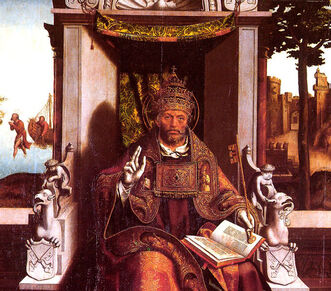 St. Peter by Grao Vasco. St. Peter is depicted with traditional Papal vestments. Note the key in his left hand, signifying the keys given by Christ to him and the other Apostles. St. Peter by Grao Vasco. St. Peter is depicted with traditional Papal vestments. Note the key in his left hand, signifying the keys given by Christ to him and the other Apostles. What sacrifice could Gentiles possibly offer to God that would be clean? Non other than the Sacrifice of the Mass, which is the clean oblation in which Christ re-presents Himself to the Father for our salvation. St. Peter: an image of both good and bad Popes The Church is a Divine Institution. She is founded by Jesus Christ, and She rests upon not only Himself but also on the unshakable rock of St. Peter. We see that the institution of the Papacy is Divinely founded by Christ; an Office of safeguarding and expounding the Deposit of Faith delivered to the saints [Jude 1:3; Acts 15:7]. And yet, Christ willed that sinful men should occupy that Office, beginning with St. Peter. Peter himself embodies all of the characteristics of both good and bad. He began life as a poor, probably a mostly illiterate, fisherman. In the space of three years, this fisherman is turned into the Vicar of Jesus Christ, the Prince of the Apostles, and the Supreme Head of the Church on earth. By the end of his life, he has travelled and preached, delivering his first sermon on Pentecost Sunday that converted 3,000 people of the spot! He eventually travelled to Rome, the Capital of the World, and established his Apostolic See there, working with St. Paul to build up the Holy Roman Church, the Mother and Mistress of all Churches. He writes two epistles, the first Papal Letters to the Church. He approves of St. Mark's Gospel, since St. Mark the Evangelist (the patron of this site) was his secretary and disciple. He later consecrates St. Mark as a bishop, and sends him to Alexandria in Egypt to establish the Church there. The Confession of this fisherman has been the rock upon which the Church has rested. Through his Successors, St. Peter still teaches and guides the Church. His Chair remains the Principle of Unity, and the Beacon of Light to the world. Though many fall away from the faith, like the pretended Reformers of the 16th Century, Peter keeps the Faith entire, whole, and pure. And yet, in his lifetime, St. Peter did some terribly things. First of which is that he publicly denied Our Lord right when Our Lord was undergoing His Passion. Peter was no where to be seen when Our Lord was being crucified. Yet, he repented, and after His Resurrection, Our Lord re-confirms Peter in his Office as Vicar of Christ [John 21:15-17], even giving him foreknowledge of his martyrdom [John 21:18-19]. Peter was also rebuked by St. Paul, when the former had publicly distanced himself away from the Gentile Christians in favour of the Jewish Christians, for fear of offending the Jewish Christians. In Peter, then, both good and bad reside, and foreshadow that both good and evil men will sit on the Chair of Peter. Yet the Office which they hold comes from Christ, and so nothing they do can ever nullify that. The actions of evil Popes does not abrogate the Papacy, since it is held up by Christ, and not by men. This is what happened at Caesarea Philippi. Christ perfectly fulfils the Old Testament:
Christ preforms a miracle: He entrusts His Authority to sinful men. And a testament to the Divine Institution of the Catholic Church is that even after 2,000 years of sinful men doing all sorts in the Church, She still stands to this very day. As a certain Cardinal said to Napoleon after the French Emperor threatened to destroy the Church: Your Majesty, we, the Catholic clergy, have done our best to destroy the Catholic Church for the last 1,800 years. We have not succeeded, and neither will you.
Many men have sought to destroy the Church. They are all dead. The Church still stands. The Church MUST win. Must ALWAYS win. St. Peter, Vicar of Jesus Christ, Prince of the Apostles, Supreme Pontiff of the Holy Church, pray for us and confirm us in the Faith!
Comments
|
Archives
January 2023
|
